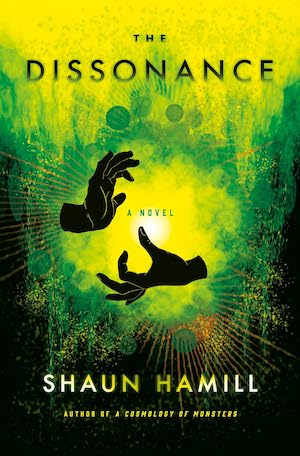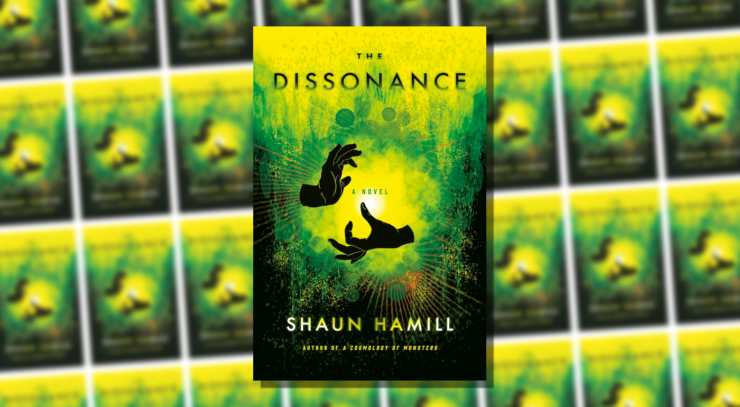On a trip to Maine three years ago, I was browsing the horror shelves at Bridgton Books when something caught my eye. The book that did so had a great title: A Cosmology of Monsters. It didn’t hurt that the front bore a blurb by Stephen King comparing the book inside to a theoretical horror novel written by John Irving. That sounded like an interesting prospect, and so I picked up the book—the debut of its author, Shaun Hamill—and quickly devoured it.
First and foremost: Yep, King’s elevator pitch was spot-on; this did indeed have some of the nuanced character work and evocative sweep that I’d normally associate with Irving. It was also a proper horror novel, one with bizarre creatures, a sense of cosmic dread, and bargains that had no good outcome. And that was what struck me the most: For all that this hewed to some traditional tenets of storytelling, the nature of its horror, and the ways that it was in some ways interwoven with desire, felt deeply idiosyncratic. From reading it, I got the sense that Hamill was tapping into very specific things that left him feeling unnerved; that, in turn, helped make the book feel fresh throughout, and ultimately took it to a distinctive ending that’s stayed with me over the years.
All of which is to say that I was both excited and a little nervous to read what Hamill did next. Cue The Dissonance, which checks off a few “yes, this is a second novel” boxes: a larger cast of characters, an ambitious structure, and a whole lot of worldbuilding. It’s also, thankfully, not A Cosmology of Monsters II—instead, The Dissonance feels like a very different, albeit still idiosyncratic, foray into the hinterlands where fantasy and horror mingle. There might be a little dark academia thrown in here, too. I’m honestly not sure, largely because I don’t quite know how best to define dark academia, except via the precept of “I’m pretty sure the author of this book liked The Secret History.” But if you dug The Magicians or Ninth House, with maybe a bit of The Umbrella Academy thrown into the mix, I suspect you’ll find plenty to savor here.
It doesn’t hurt that The Dissonance has an absolute firecracker of a first sentence:
Twenty-one years after killing his mother and one year after killing a man in a bar fight, Hal Isaac stands on the steps of St. Matthew’s Catholic Church in Vandergriff, Texas and smokes a cigarette.
Quickly, Hamill fills in more details. Hal is at the church for an AA meeting; his legal fate is still up in the air. He also has the ability to light a cigarette using supernatural methods, along with a passing mention that he had the ability to do “far more impressive things” in his youth. And he’s just been invited to a memorial service for something that took place at his high school 20 years earlier.
Buy the Book


The Dissonance
In short order, Hamill introduces the other characters around whom this novel revolves. This includes two former classmates of Hal’s, Erin and Athena, and a teenager named Owen, whose connection to them is unclear at the book’s outset. When we first meet Owen, he and some friends are attempting an occult ritual; something goes very wrong, killing Owen’s friends and resulting in some sort of entity taking over the body of Cole, the subject of Owen’s crush.
Hamill employs a parallel structure to tell this story, showing us Hal, Erin and Athena in the present and also during their youth, when they studied a type of magic known as the Dissonance. They did so with their friend Peter, whose grandfather, Mr. Marsh, led their instruction. It’s clear from the absence of both Peter and his grandfather in the present-day sequences that something unpleasant lies in their future. Meanwhile—also in the present—the being in Cole’s body leads Owen on a set of tasks; if you suspect that their path will eventually cross with that of Athena, Erin, and Hal, you’re not wrong.
The centerpiece of The Dissonance is the process of the quartet of young friends being tutored in the art of the Dissonance. What is most interesting about this is the way that Hamill depicts what’s essentially a magical underworld; this isn’t a book where a school for magic exists hidden away from the rest of the world, nor does it exist in full view of the world. Instead, the Dissonance—and its practitioners, the Dissonants—occupy a space somewhere between academic subcultures and elite chess. There’s one sequence in which Marsh takes his students to a conference, where they and we learn that he’s something of an outcast in the community. The conference they attend also abounds with papers delivered on just what the Dissonance is—and whether its power might be theological in origin.
The worldbuilding here is fascinating, from the irony of academic detachment being used to analyze wild magic to the flying competitions that Dissonants engage in. This does not seem to be the first volume of a stealth trilogy; still, Hamill has clearly done a lot of work to create both an interesting system of magic and an equally interesting way in which the knowledge of it is spread, and the glimpse of the wider world of Dissonants that Athena and company get turns a lot of this genre’s tropes on its head.
[Spoilers follow.]
It’s in the character of Marsh that Hamill both carves out an interesting space and, unfortunately, taps into a storytelling beat that feels overly familiar. The notion that the wise mentor might be less of a visionary and more of a crank is an appealing one, and Marsh’s students’ gradual realization that their teacher might be estranged from the wider magical community for a reason nestles in well with the growing sense of doom in that thread of the plot.
On the other hand, Hamill also does a lot to establish these students as underdogs, and when they venture to the conference, that motif is particularly prominent. Given that Marsh—again, spoilers —turns out to be more antagonist than mentor, it further complicates that sensibility. (It’s also one of a number of recent fantasy novels I’ve read where the irascible mentor turns out to be villainous; it’s an understandable subversion of genre tropes, but it’s also starting to feel like a cliché on its own.) I don’t think Hamill is implying that the broader Dissonance community was right to gaze askance at Hal, Athena, Erin, and Peter—but it’s a challenging set of emotional beats to map.
There are a few other moments here where I found myself wishing that this book was slightly longer. In an early scene, Athena meets with Garrett, who she first met at that fateful gathering of Dissonants years earlier. This scene, and its suggestion of different magical subcultures, points to a larger world that Hamill doesn’t really explore. And while “always leave them wanting more” is good advice for a reason, the worldbuilding here is compelling enough that I nonetheless wanted more glimpses of this world.
If I seem overly critical of these aspects of The Dissonance, I don’t want to give the impression that I disliked the book. It was a compelling read, with its temporally and geographically separated plot lines converging memorably and its characters reacting realistically to a universe that grows increasingly surreal as the plot progresses. Hamill set the bar very high with his first novel, and it’s refreshing to see him set out in a new direction with this one. Even if elements of it frustrate at times, its strengths are numerous enough to keep a reader hooked—and, hopefully, savoring more when it’s all over.
The Dissonance is published by Pantheon.










